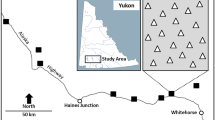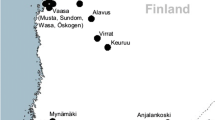Abstract
To devise effective conservation actions, it is important to know which factors are associated with the population parameters of a declining population. Using mark–recapture methods, we estimated the annual population size, growth rate and survival probability of an ear-tagged flying squirrel population over a 15-year period in a 4,500 ha study area in western Finland. The species is considered vulnerable, but detailed knowledge concerning population sizes or trends is lacking. The population parameters and changes therein were regressed against habitat availability, an indicator of predation pressure, and mean winter temperature (an indicator of climate change), to reveal potential reasons for trends in the population. The best-fit models suggested the annual growth rate to be below one, and on average it was 0.93 (±0.06; SE) across the 15-year period. The survival probability was about 0.22 (±0.03) for juveniles and 0.50 (±0.03) for adults. The population size of adult flying squirrels decreased from 65 (±11) individuals in 1995 to 29 (±6) individuals in 2009. The number of flying squirrels was associated with the amount of available habitat, but the decline in population size was more rapid than the loss of habitat area. If the current decreasing trend in habitat availability continues, the population might become extinct by the year 2020. To halt the population decline, it is necessary to refrain from clear-cutting mature spruce stands until new suitable habitats develop from the maturation of younger forests.



Similar content being viewed by others
References
ACIA (2005) Arctic climate impact assessment. Cambridge University Press, Cambridge
Angelstam P, Lindström E, Widén P (1984) Role of predation in short-term population fluctuations of some birds and mammals in Fennoscandia. Oecologia 62:199–208
Bender DJ, Contreras TA, Fahrig L (1998) Habitat loss and population decline: a meta-analysis of the patch size effect. Ecology 79:517–533
Caughley G (1994) Directions in conservation biology. J Anim Ecol 63:215–244
Choquet R, Reboulet AM, Lebreton JD, Gimenez O, Pradel R (2005) U-CARE 2.2 User’s manual. CEFE, Montpellier
Cooch E, White G (eds) (2009) Program MARK: a gentle introduction, 7th edn. http://www.phidot.org/software/mark/docs/book/
Finnish Statistical Yearbook of Forestry (2011) Finnish Forest Research Institute, Vantaa (http://www.metla.fi/julkaisut/metsatilastollinenvsk/index-en.htm)
Forsman JT, Mönkkönen M (2003) The role of climate in limiting European resident bird populations. J Biogeogr 30:55–70
Hanski IK (1998) Home ranges and habitat use in the declining flying squirrel Pteromys volans in managed forests. Wildl Biol 4:33–46
Hanski IK (2006) Liito-oravan Pteromys volans Suomen kannan koon arviointi. Loppuraportti. Ympäristöministeriö, Helsinki (in Finnish with Swedish abstract)
Hanski IK, Stevens P, Ihalempiä P, Selonen V (2000) Home-range size, movements, and nest-site use in the Siberian flying squirrel, Pteromys volans. J Mammal 81:798–809
Hanski IK, Henttonen H, Liukko U-M, Meriluoto M, Mäkelä A (2001a) Liito-oravan (Pteromys volans) biologia ja suojelu Suomessa. Suomen ympäristö 459, Ympäristöministeriö, Helsinki (in Finnish with Swedish abstract)
Hanski I, Henttonen H, Korpimäki E, Oksanen L, Turchin P (2001b) Small-rodent dynamics and predation. Ecology 82:1505–1520
Hokkanen H, Törmälä T, Vuorinen H (1982) Decline of the flying squirrel Pteromys volans L. populations in Finland. Biol Conserv 23:273–284
Huitu O, Norrdahl K, Korpimäki E (2003) Landscape effects on temporal and spatial properties of vole population fluctuations. Oecologia 135:209–220
Hurvich CM, Tsai C-L (1989) Regression and time series model selection in small samples. Biometrika 76:297–307
IUCN (2001) IUCN red list categories and criteria: version 3.1. IUCN species survival commission. IUCN, Gland
Kellomäki S, Peltola H, Nuutinen T, Korhonen KT, Strandman H (2008) Sensitivity of managed boreal forests in Finland to climate change with implications for adaptive management. Philos Trans R Soc B 363:2341–2351
Korpimäki E, Norrdahl K (1991) Numerical and functional responses of kestrels, short-eared owls, and long-eared owls to vole densities. Ecology 72:814–826
Korpimäki E, Huhtala K, Sulkava S (1990) Does the year-to-year variation in the diet of eagle and Ural owls support the alternative prey hypothesis? Oikos 58:47–54
Korpimäki E, Norrdahl K, Rinta-Jaskari T (1991) Responses of stoats and least weasels to fluctuating food abundances: is the low phase of the vole cycle due to mustelid predation? Oecologia 88:552–561
Korpimäki E, Norrdahl K, Huitu O, Klemola T (2005) Predator-induced synchrony in population oscillations of co-existing small mammal species. Proc R Soc Lond B 272:193–202
Kuuluvainen T, Tahvonen O, Aakala T (2012) Even-aged and uneven-aged forest management in boreal Fennoscandia: a review. Ambio 41:720–737
Lampila S, Wistbacka R, Mäkelä A, Orell M (2009) Survival and population growth rate of the threatened Siberian flying squirrel (Pteromys volans) in a fragmented forest landscape. Ecoscience 16:66–74
Lande R (1998) Anthropogenic, ecological and genetic factors in extinction and conservation. Res Popul Ecol 40:259–269
Lebreton J-D, Burnham KP, Clobert J, Anderson DR (1992) Modeling survival and testing biological hypotheses using marked animals: a unified approach with case studies. Ecol Monogr 62:67–118
Mäkelä A (1999) Liito-oravan elinalueet ja elinympäristön määrä Alavudella 1981 ja 1998. Luonnon Tutkija 2:56–57 (in Finnish)
Mäkelä A (2001) Liito-oravan (Pteromys volans L.) esiintyminen ja lajille sopivan elinympäristön määrä Alavuden Sulkavankylän tutkimusalueella vuosien 1981 ja 1998 inventointien perusteella. In: Hanski IK, Henttonen H, Liukko U-M, Meriluoto M, Mäkelä A (eds) Liito-oravan (Pteromys volans) biologia ja suojelu Suomessa. Suomen ympäristö 459, Ympäristöministeriö, Helsinki, pp 76–80 (in Finnish with Swedish abstract)
Norrdahl K, Korpimäki E (1995) Mortality factors in a cyclic vole population. Proc R Soc Lond B 261:49–53
Norrdahl K, Korpimäki E (2002) Seasonal changes in the numerical responses of predators to cyclic vole populations. Ecography 25:428–438
Rassi P, Hyvärinen E, Juslén A, Mannerkoski I (eds) (2010) Suomen lajien uhanalaisuus—punainen kirja 2010. Ympäristöministeriö and Suomen ympäristökeskus, Helsinki (in Finnish with English summary)
Reunanen P, Mönkkönen M, Nikula A (2000) Managing boreal forest landscapes for flying squirrels. Conserv Biol 14:218–226
Reunanen P, Mönkkönen M, Nikula A, Hurme E, Nivala V (2004) Assessing landscape thresholds for the Siberian flying squirrel. Ecol Bull 51:277–286
Santangeli A, Wistbacka R, Hanski IK, Laaksonen T (2013) Ineffective enforced legislation for nature conservation: a case study with Siberian flying squirrel and forestry in a boreal landscape. Biol Conserv 157:237–244
Selonen V, Hanski IK (2004) Young flying squirrels (Pteromys volans) dispersing in fragmented forests. Behav Ecol 15:564–571
Selonen V, Hanski IK, Stevens PC (2001) Space use of the Siberian flying squirrel Pteromys volans in fragmented forest landscapes. Ecography 24:588–600
Selonen V, Hanski IK, Desrochers A (2007) Natal habitat-biased dispersal in the Siberian flying squirrel. Proc R Soc Lond B 274:2063–2068
Selonen V, Sulkava P, Sulkava R, Sulkava S, Korpimäki E (2010) Decline of flying and red squirrels in boreal forests revealed by long-term diet analyses of avian predators. Anim Conserv 13:579–585
Sulkava R, Mäkelä A, Kotiaho JS, Mönkkönen M (2008) Difficulty of getting accurate and precise estimates of population size: the case of the Siberian flying squirrel in Finland. Ann Zool Fennici 45:521–526
Sundell J, Huitu O, Henttonen H, Kaikusalo A, Korpimäki E, Pietiäinen H, Saurola P, Hanski I (2004) Large-scale spatial dynamics of vole populations in Finland revealed by the breeding success of vole-eating avian predators. J Anim Ecol 73:167–178
Venäläinen A, Tuomenvirta H, Drebs A (2005) A basic Finnish climate data set 1961–2000: description and illustrations. Finnish Meteorological Institute Reports 5
White GC, Burnham KP (1999) Program MARK: survival estimation from populations of marked animals. Bird Study 46:120–138
Williams BK, Nichols JD, Conroy MJ (2002) Analysis and management of animal populations. Academic Press, San Diego
Acknowledgments
This manuscript was reviewed at Peerage of Science. We are grateful to two anonymous peers at the Peerage of Science and three reviewers for their useful comments. The study was financially supported by the South Ostrobothnia Regional fund of the Finnish Cultural Foundation (to JK), the Academy of Finland (Grant No. 133495 to OH; Grant No. 7115560 to MM) and by Maj and the Tor Nessling Foundation (Project# 2012580 to MM).
Author information
Authors and Affiliations
Corresponding author
Rights and permissions
About this article
Cite this article
Koskimäki, J., Huitu, O., Kotiaho, J.S. et al. Are habitat loss, predation risk and climate related to the drastic decline in a Siberian flying squirrel population? A 15-year study. Popul Ecol 56, 341–348 (2014). https://doi.org/10.1007/s10144-013-0411-4
Received:
Accepted:
Published:
Issue Date:
DOI: https://doi.org/10.1007/s10144-013-0411-4




